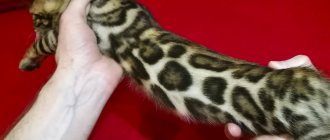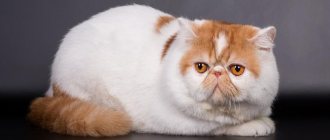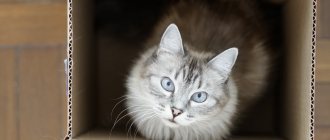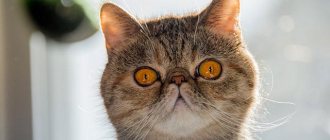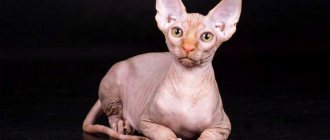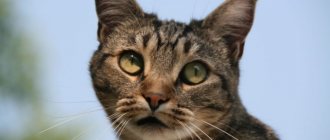Brazilian Shorthairs are domestic cats with a discreet appearance, an independent disposition and a soulful, bewitching gaze. Despite their ordinary exterior and resemblance to yard cats, they are not as simple as they seem.
To understand why Brazilian Shorthairs are so popular in their homeland, let’s look at the characteristics of this breed.
Brief history of the breed
These unremarkable cats simply lived on the streets of Brazil and did not attract the attention of local residents. And it is unknown how their future fate would have developed if professional felinologists had not become interested in them in the 80s of the last century.
Local experts began to select kittens with dominant characteristics of the breed and use them for breeding. As a result, by 1985 they developed the Brazilian Shorthair standard. At the same time, they submitted an application to register a new breed of cats, which remained unsatisfied.
Brazilian cats were combined with their European counterparts and classified as Celtic Shorthairs. But felinologists decided not to give up and continued to prove the uniqueness of the new breed. And in 1999, the WCF organization assigned the Brazilian Shorthair the status of an independent cat variety.
Photo
Let me introduce you – Consuela, a cat from Brazil. The only cat in the world that really sings! At the age of 5, she began to imitate her 17-year-old owner when she practiced vocals. Today she can reproduce notes of the first and second octave, does not go out of tune and is able to sing 36 songs, including the La Traviata aria, compositions by Elvis Presley and even Bach! Consuela can perform both in pairs and solo and successfully tours, poses for photos and appears on posters.
Breed description, standards, appearance
Brazilian Shorthairs are graceful, slender cats with a slightly elongated, strong body and well-developed muscles. All characteristics of the breed are described in the official standard.
Dimensions and weight
The Brazilian cat is an elegant animal with average body parameters. Adult representatives of the breed weigh 3-5 kg. Moreover, cats look a little larger than cats.
Anatomical characteristics
A typical Brazilian cat should fit the following description:
- The head is elongated, of medium size, with a moderately long nose, smooth stop and a strong, slightly protruding chin.
- The ears are straight, regular triangular in shape, set wide apart. Can be decorated with neat tassels.
- The eyes are almond-shaped, slightly slanted, with an intelligent, penetrating gaze. The distance between the eyes is 1.5 times their width. The color of the iris can be any, but must be in harmony with the color of the coat. White Brazilian cats have blue eyes. In silvery individuals, the iris is green or yellow.
- The body is medium in size, rectangular in shape, with a rounded chest and developed muscles. The neck is muscular and strong.
- Limbs of equal length with small round paws.
- The tail is proportional to the body. Wide at the base, gradually tapering towards the tip.
Color and coat type
Brazilian cats have short, close-fitting, silky-to-the-touch fur with no undercoat at all.
The breed standard allows for the existence of any colors, with the exception of point variations.
Possible breed defects
Flaws in appearance that affect a decrease in expert assessment:
- presence of undercoat;
- small stature;
- minor deviations from the standard.
Defects for which the Brazilian Shorthair is subject to disqualification:
- disturbances in the structure of the body;
- lack of claws;
- cryptorchidism;
- deafness.
Character and temperament
Brazilian cats have an affectionate and calm disposition. They treat all family members well, but do not like to be held. Freedom-loving, moderately talkative Brazilian cats rarely show importunity and calmly tolerate loneliness.
On a note. Although representatives of this breed have an independent character, they need their owner's love and care. Cats left unattended can become irritable and aggressive.
Brazilian Shorthairs get along well with children and willingly take part in outdoor games. But if a child does not know how to handle animals and offends them, then there is a risk that the pet will defend itself with its claws.
Cats of this breed do not conflict with their brothers and good-natured dogs, but do not tolerate rodents near them.
How to choose the right kitten
Outside of Brazil, there are practically no nurseries that specialize in breeding this breed of cats. Therefore, buying a Brazilian Shorthair can turn into a kind of lottery.
In order not to run into scammers and not to shell out a tidy sum for an ordinary yard kitten, before purchasing an animal you need to make sure that it has documents confirming its origin and vaccinations.
When choosing a pet, you need to pay attention to the following characteristics:
- compliance with breed standards;
- physical activity;
- behavioral characteristics;
- skin and coat condition;
- cleanliness of ears and eyes;
- appetite.
Kitten care
Although Brazilian Shorthair kittens come from the cattery to their owners fully prepared for independent living, they require attention and care. At the initial stage, they are given a little time to adapt, and are also shown where they can eat, sleep and relieve themselves.
In order not to aggravate the stress of a change of environment, at first the little Brazilian is fed what the breeder advised. New foods are introduced into the kitten’s diet gradually. This will allow you to monitor whether they cause stomach upset or allergies. The Brazilian is fed small portions, but often. As you age, the number of meals you eat decreases.
To prevent the kitten from getting injured, wires, household chemicals and small objects are hidden from it in the new house. Also, indoor plants are removed from the little Brazilian, since many of them are poisonous to animals.
Breeders
Since their allergic owners do not experience problems with this breed of cats, there is a statement that short-haired “Brazilians” are hypoallergenic.
The founder of the first Federation of Brazilian cats was the engineer Paulo Samuel Ruschi. He founded the very first cat club in Rio de Janeiro. In 1988, he and his German colleague Anneliese Hackmann founded the World Cat Federation (WCF), which initially consisted only of those clubs created by these two, but later became the largest in the world. There is also the Brazilian International Shorthair Society, which is a member of the WCF and is headquartered in New York. The Brazilian Shorthair project is being run under his management.
This is how the dream of Brazilian Shorthair breeders came true to make this breed unique and purebred. Also one of the famous breeders is Silvia de Carvalho, a famous veterinarian and cat breeder, as well as a part-time artist. In her nursery called “Syarte” she has been breeding “Brazilians” for more than 10 years. Several breeders followed in her footsteps. And now the breed is so widespread that at every WCF exhibition held in Brazil, you can meet Brazilian Shorthairs. Their pedigree is based on several generations, among which there are no longer wild cats, this gives them the right to compete with other popular breeds. Now the Brazilian Shorthair is known in different countries of the world - in particular, in the USA, Japan, Australia, Germany, and England.
But even despite this success of breeders, there are still not many Brazilian shorthairs in their homeland. Opposition from animal rights activists, as well as professional cat breeders, did not contribute to the development of random street cats, which at one time were the founders of the breed. Therefore, in the successful breeding of the breed, not everything went so smoothly.
Care and maintenance
The Brazilian Shorthair cat does not have an undercoat and does not tolerate dampness and low temperatures. For a comfortable life, she needs a warm and dry room with access to fresh air.
In order for a Brazilian to look neat, he is provided with appropriate hygienic care:
- The cat's eyes and ears are regularly wiped with a dampened cotton swab and inspected for unusual or excessive discharge.
- The claws of the Brazilian Shorthair are trimmed as necessary with a nail clipper so as not to touch living tissue and cause pain to the animal.
- Brush your cat's teeth weekly with a soft brush and a small amount of non-foaming toothpaste.
The coat of the Brazilian breed does not require special care. To maintain an aesthetic appearance, it is periodically combed with a medium-hard brush.
On a note. Brazilian cats do not like water, so in order not to expose the animals to unnecessary stress, they should only be bathed when absolutely necessary.
Feeding the cat
In order for the Brazilian Shorthair to receive the entire range of vitamins and microelements along with its food, it is advisable to feed it with premium or super-premium drying. A cat of this breed is well suited for the following brands:
- Bosch;
- Royal Canin;
- Pro Plan;
- Pronature.
On a note. A dry-fed Brazilian cat should have easy access to clean drinking water.
With a natural type of feeding, the diet of a representative of the breed is designed so that it contains 70-80% meat. The Brazilian cat is also given fermented milk products, vegetables, cereals, ocean fish and eggs.
In order for the pet to remain healthy and active for a long time, sausages, smoked meats, onions, pork, potatoes, pastries, sweets and any food from the owner’s table are completely excluded from its menu.
If a Brazilian eats natural food, mineral supplements are additionally included in his diet. They are given twice a year, after preliminary consultation with a veterinarian.
What to feed your Brazilian Shorthair?
If you choose between a large number of feeds, then you should give your preference to premium food. Such cats are not at all picky, and even if you offer them simpler food, they will not refuse it. But is it worth it, because the health of your pet is much more important.
You can also feed your cat natural food, which includes meat along with dairy products. It is better to exclude any fresh fish from the diet, because through it you can become infected with worms.
It is worth taking care of your pet and not feeding it chicken skin or starchy vegetables, because, as experienced breeders note, not all cats have a digestive system in good condition. It is also not permissible to give red vegetables to animals of this breed. The cat's gastrointestinal tract is not able to digest such food.
laperm - description of the breed and character of the cat
Education and physical activity
Brazilian cats are energetic and active animals. Even in adulthood, they will not refuse to chase a ball or a laser pointer. To realize their hunting instincts, they will need several interactive toys. And so that cats of this breed can stretch their muscles, they have a sports corner.
Shorthaired Brazilians are endowed with outstanding mental abilities. Cats of this breed quickly adapt to different conditions and are easy to train. Brazilians not only easily learn basic rules of behavior, but also remember simple commands.
Health and susceptibility to disease
The Brazilian Shorthair is an indigenous breed that was formed in natural conditions without human intervention. Thanks to this, cats have good health and live about 15-20 years. They are not prone to serious hereditary pathologies and are little susceptible to infectious diseases.
On a note. Practice shows that in rare cases, Brazilians experience problems with the skin and digestive system. But all of them are caused by poor nutrition and can be treated.
Acquisition
Unfortunately, it is very difficult to buy this cat in the territory of the former Soviet Union. In our countries, this breed is still not popular, and it is almost impossible to find information about the owners of these cats and nurseries. But occasionally you can find advertisements on the Internet where kittens of these cats are sold at a price of 350-500 dollars.
Brazilians have excellent health
If you find an error, please select a piece of text and press Ctrl+Enter.
Pros and cons of the breed
Brazilian cats, like representatives of any other breed, have not only advantages, but also disadvantages:
| pros | Minuses |
| Good health | Rarity of the breed |
| Good character | |
| Low maintenance |
Brazilian Shorthairs are animals that can easily be confused with their outbred relatives. But their developed intelligence, good health, excellent character and high adaptability make them almost ideal companions.
Owner reviews
Due to the low prevalence of these cats in Russia, there are few reviews about them, but those owners who are lucky enough to get to know Brazilian cats better note their friendliness and non-conflict. Cats have also been noted to be careful with children. Owners also note their good immunity and rare incidence of illness.
Conclusion
The Brazilian beauty is a good companion for a large family. She will be able to console you in sorrow and share joy, and will also become the guardian of your food supplies. If you manage to find a Brazilian cat, consider yourself lucky.
